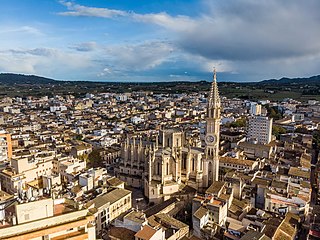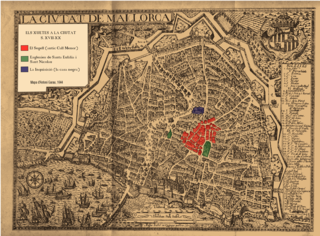
Mallorca, or Majorca, is the largest island in the Balearic Islands, which are part of Spain and located in the Mediterranean.

Cabrera is an island in the Balearic Islands, Spain, located in the Mediterranean Sea off the southern coast of Majorca. It is a National Park. The highest point is Na Picamosques.

Palma is the capital and largest city of the autonomous community of the Balearic Islands in Spain. It is situated on the south coast of Mallorca on the Bay of Palma. The Cabrera Archipelago, though widely separated from Palma proper, is administratively considered part of the municipality. As of 2018, Palma Airport serves over 29 million passengers per year.

Bellver Castle is a Gothic-style castle on a hill 3 km to the west of the center of Palma on the Island of Majorca, Balearic Islands, Spain. It was built in the 14th century for King James II of Majorca, and is one of the few circular castles in Europe. First serving as the residence of the Kings of Majorca, and afterward long used as a military prison throughout the 18th to mid-20th century, it is now under civilian control, being one of the main tourist attractions of the island, as well as the seat for the city's History Museum.

Inca is a town on the Spanish island of Mallorca. The population of the municipality is 32,137 (2018) in an area of 58.4 km².

Manacor is a town and municipality on the island of Mallorca, part of the Spanish autonomous community of the Balearic Islands. It is the second largest town in Mallorca, after the capital of Palma. The municipality has tourist areas such as Porto Cristo, site of the famous Caves of Drach, and Cales de Mallorca. Manacor has one of the busiest street markets on the island, held every Monday morning. Manacor is famous for high-quality wood furniture manufacture and artificial pearls.

Serveis Ferroviaris de Mallorca or SFM is a company which operates the metre gauge railway network on the Spanish island of Majorca. The total length, including Palma Metro, also operated by this company, is 85 km.

Ball de bastons is the name of a ritual weapon dance spread throughout Europe and the rest of the Iberian area but mostly in Catalonia. English and Welsh Morris dances are well-known relatives to these traditions. The origins of dance are difficult to reference; first recorded mention dates to 1150, in a banquet of Count Berenguer IV)

Artà is one of the 53 independent municipalities on the Spanish Balearic island of Majorca. The small town of the same name is the administrative seat of this municipality in the region (Comarca) of Llevant.

Esporles is a locality and Spanish municipality of the autonomous community of the Balearic Islands. Situated on the island of Majorca, around the zone of the Serra de Tramuntana. It's about 15 km from Palma de Mallorca. The town is divided into Vilavella and Vilanova. In its territory it also includes small urbanizations, like Ses Rotgetes de Canet y Es Verger.

Sant Llorenç des Cardassar is a small municipality on Mallorca, one of the Balearic Islands, Spain.

The Xuetes are a social group on the Spanish island of Majorca, in the Mediterranean Sea, who are descendants of Majorcan Jews that either were conversos or were Crypto-Jews, forced to keep their religion hidden. They practiced strict endogamy by marrying only within their own group. Many of their descendants observe a syncretist form of Christian worship known as Xueta Christianity.

The xeremia is a type of bagpipe native to the island of Majorca (Mallorca). It consists of a bag made of skin, known as a sac or sarró which retains the air, a blowpipe (bufador), a melody pipe or chanter (grall), and several, generally three, drones (bordons). The primary drone (roncó) sounds a tonic note, but the other drones are sometimes simply false drones for ornamentation.
The Majorca rail network consists of three separate electrified lines, which radiate north and east from Palma de Mallorca, the major city on the Spanish island of Majorca.

The Balearic Islands are an archipelago in the Balearic Sea, near the eastern coast of the Iberian Peninsula. The archipelago is an autonomous community and a province of Spain; its capital is Palma. The 2007 Statute of Autonomy designates the Balearic Islands as one of the nationalities of Spain. The official languages of the Balearic Islands are Catalan and Spanish.

S'illot is a small tourist town on the south east coast of the Balearic Island of Mallorca, Spain, divided between the council areas of Manacor and Sant Llorenç des Cardassar. The two districts are separated by the river Torrent de Ca n'Amer which is spanned by a large bridge in the town. A range of seaside leisure activities take place in the town. At the entrance to the town there is prehistoric settlement that is well preserved.

The conquest of the island of Majorca on behalf of the Christian kingdoms was carried out by King James I of Aragon between 1229 and 1231. The pact to carry out the invasion, concluded between James I and the ecclesiastical and secular leaders, was ratified in Tarragona on 28 August 1229. It was open and promised conditions of parity for all who wished to participate.

The Battle of Portopí was an open field military conflict between the Almohad troops that occupied the island of Majorca and the Christian army led by King James I the Conqueror with the aim of annexing it to the Crown of Aragon in order to expand their domain. It was carried out at various points in the current Sierra de Na Burguesa, approximately halfway between the current resort town of Santa Ponsa and the City of Majorca. It was the second major battle in the campaign for the conquest of the island of Majorca initiated by the Aragonese king.
The following is a timeline of the history of the city of Palma, Spain.
















